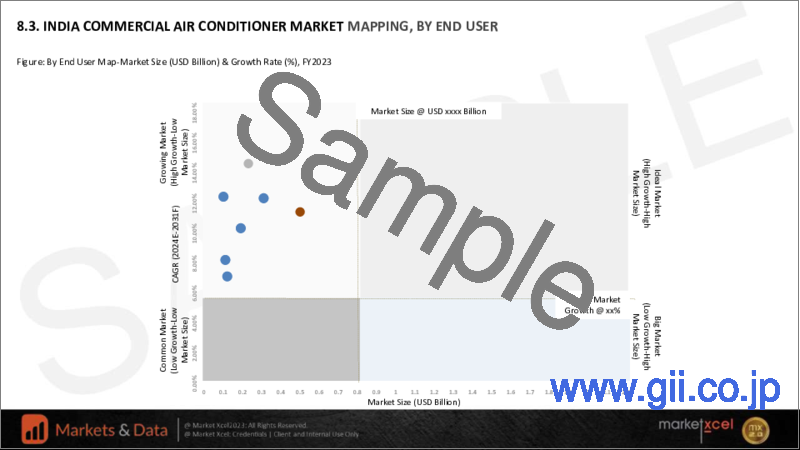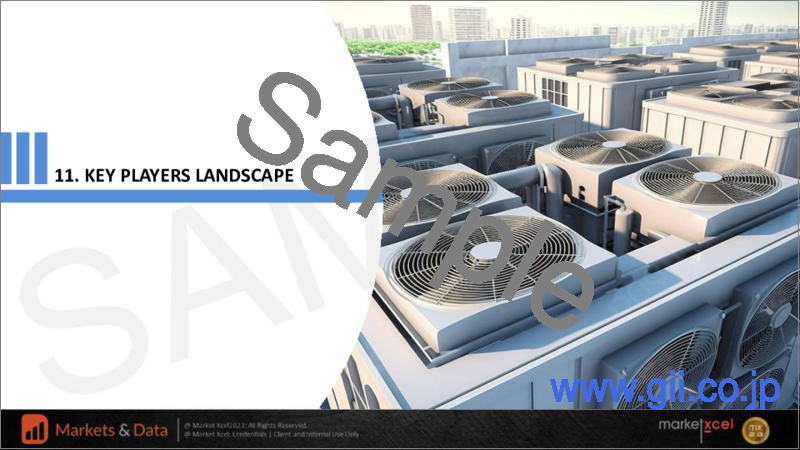|
|
市場調査レポート
商品コード
1277758
業務用エアコンのインド市場の評価:タイプ別、電力量別、エンドユーザー別、流通チャネル別、地域別、機会、予測(2017年~2031年)India Commercial Air Conditioner Market Assessment, By Type, By Capacity, By End-user, By Distribution Channel, By Region, Opportunities, and Forecast, 2017-2031F |
||||||
|
● お客様のご希望に応じて、既存データの加工や未掲載情報(例:国別セグメント)の追加などの対応が可能です。 詳細はお問い合わせください。 |
|||||||
| 業務用エアコンのインド市場の評価:タイプ別、電力量別、エンドユーザー別、流通チャネル別、地域別、機会、予測(2017年~2031年) |
|
出版日: 2023年05月22日
発行: Market Xcel - Markets and Data
ページ情報: 英文 80 Pages
納期: 3~5営業日
|
- 全表示
- 概要
- 図表
- 目次
インドの業務用エアコンの市場規模は、2023年度の21億2,000万米ドルから2031年度には54億9,000万米ドルに達し、2024年度~2031年度にCAGRで12.62%の成長が予測されています。市場は、主にTier2都市で急成長しているIT部門による、国内でのビジネススペースやコワーキングスペースに向けた商業建設の増加によって牽引されています。
当レポートでは、インドの業務用エアコン市場について調査分析し、市場規模と予測、市場力学、主要企業の情勢と見通しなどを提供しています。
目次
第1章 調査手法
第2章 プロジェクトの範囲と定義
第3章 インドの業務用エアコン市場に対するCOVID-19の影響
第4章 インドの業務用エアコン市場に対するロシア・ウクライナ戦争の影響
第5章 エグゼクティブサマリー
第6章 顧客の声
- 人口統計別(年齢、収入、地域、性別、世帯規模など)
- ブランドの認知度とロイヤルティ
- 購買行動分析
- 購入決定に影響を与える要因
- 将来の購入の意図
- 購入期間の選好
- 購入チャネル
- ライフスタイルの動向
- プロダクトオーナーの悩みの領域
第7章 インドの業務用エアコン市場の見通し(2017年度~2031年度)
- 市場規模と予測
- 金額
- 数量
- タイプ別
- セントラル
- パッケージ
- ダクトレス
- マルチスプリット
- VRF
- その他
- 電力量別
- 10kW未満
- 10kW~20kW
- 20kW~30kW
- 30kW超
- エンドユーザー別
- 小売
- オフィス
- ホスピタリティ
- 病院
- フードサービス
- 教育機関
- その他
- 流通チャネル別
- オンライン
- オフライン
- 地域別
- 東部
- 西部・中部
- 北部
- 南部
- 市場シェア:企業別(2023年度)
第8章 市場マッピング(2023年度)
- タイプ別
- 電力量別
- エンドユーザー別
- 流通チャネル別
- 地域別
第9章 マクロ環境と業界構造
- バリューチェーン分析
- 需給の分析
- 輸出入の分析
- PESTEL分析
- ポーターのファイブフォース分析
第10章 市場力学
- 成長機会
- 成長抑制要因(課題と抑制要因)
第11章 主要企業情勢
- SWOT分析(市場企業上位5社)
- マーケットリーダー主要5社の競合マトリックス
- マーケットリーダー主要5社の企業シェア分析(2023年度)
- 合併と買収/合弁事業(該当する場合)
第12章 価格分析
第13章 ケーススタディ
第14章 主要企業の見通し
- Daikin Industries Ltd.
- Hitachi, Ltd.
- Voltas Limited
- Blue Star Ltd.
- Mitsubishi Electric Corporation
- Carrier Global Corporation
- Samsung India Electronics Private Limited
- Haier Appliances India Pvt. Ltd
- Havells India Limited
- Fujitsu General Limited
第15章 戦略的考察と推奨事項
第16章 当社について・免責事項
List of Tables
- Table 1. Pricing Analysis of Products from Key Players
- Table 2. Competition Matrix of Top 5 Market Leaders
- Table 3. Mergers & Acquisitions/ Joint Ventures (If Applicable)
- Table 4. About Us - Regions and Countries Where We Have Executed Client Projects
List of Figures
- Figure 1. India Commercial Air Conditioner Market, By Value, In USD Billion, FY2017-2031F
- Figure 2. India Commercial Air Conditioner Market, By Volume, In Units, FY2017-2031F
- Figure 3. India Commercial Air Conditioner Market Share, By Type, In USD Billion, FY2017-2031F
- Figure 4. India Commercial Air Conditioner Market Share, By Type, In Units, FY2017-2031F
- Figure 5. India Commercial Air Conditioner Market Share, By Capacity, In USD Billion, FY2017-2031F
- Figure 6. India Commercial Air Conditioner Market Share, By Capacity, In Units, FY2017-2031F
- Figure 7. India Commercial Air Conditioner Market Share, By End-user, In USD Billion, FY2017-2031F
- Figure 8. India Commercial Air Conditioner Market Share, By End-user, In Units, FY2017-2031F
- Figure 9. India Commercial Air Conditioner Market Share, By Distribution Channel, In USD Billion, FY2017-2031F
- Figure 10. India Commercial Air Conditioner Market Share, By Distribution Channel, In Units, FY2017-2031F
- Figure 11. India Commercial Air Conditioner Market Share, By Region, In USD Billion, FY2017-2031F
- Figure 12. India Commercial Air Conditioner Market Share, By Region, In Units, FY2017-2031F
- Figure 13. By Type Map-Market Size (USD Billion) & Growth Rate (%), FY2023
- Figure 14. By Capacity Map-Market Size (USD Billion) & Growth Rate (%), FY2023
- Figure 15. By End-user Map-Market Size (USD Billion) & Growth Rate (%), FY2023
- Figure 16. By Distribution Channel Map-Market Size (USD Billion) & Growth Rate (%), FY2023
- Figure 17. By Region Map-Market Size (USD Billion) & Growth Rate (%), FY2023
The India Commercial Air Conditioner Market was estimated at USD 2.12 billion in FY2023 and is forecast to reach USD 5.49 billion by FY2031, growing at a CAGR of 12.62% between FY2024-FY2031. The market is highly driven by the rising commercial construction in the country mainly for business spaces and co-working spaces owing to a rapidly growing IT sector mainly in tier 2 cities.
Despite the obstacles and interruptions to supply lines and manufacturing brought in by COVID-19 pandemic, the demand for new buildings and construction activities has not slowed down. Rather, there has been a boom in construction sector especially for the bigger office spaces considering the social distancing notions which have become a common practice now. Multifamily, warehouse, education centres, and office projects are all part of this construction boom.
Schools have been a major driving force resulting in a higher demand on air conditioners as major educational institutes including schools, universities, academic centres, along with their transportation facilities are turning into fully air-conditioned premises.
Uncertain climate conditions in India results in severe heat waves and thus demands for a sustainable cooling strategy. Due to improved economic conditions, urbanization, and rising pollution levels, extreme climatic conditions in states like Hyderabad, Gujarat, Delhi, Mumbai, India's commercial air conditioner market is anticipated to expand considerably. Key manufactures are also concentrating on creating efficient refrigerants with low emission levels. Additionally, the market has seen rise due to the country's increasing temperature. On the flip side, rising energy bills, high installation system costs, climate change, and increased maintenance expenses are various challenges faced by the market which is driving the sales of innovative and technologically advanced air conditioners that are cost efficient and low on maintenance. According to the World Bank, a sustainable cooling strategy may open an investment opportunity of $1.6 trillion by 2040.
Rise in Commercial Spaces Drives the Market
Due to rising employment and corporate activities, the demand for coworking spaces is growing as more businesses restructure their operations to accommodate emerging technology. This trend is seen mostly in metropolitan cities of India, thereby, increasing the demand for commercial air conditioners. Additionally, due to change in lifestyle, consumers prefer to spend their leisure time in HoReCa (hotels, restaurants, and cafes), theatres and sport facilities that are fully air-conditioned. Furthermore, after the COVID-19, there is increase in the precautions level among Indian population, which has increased the demand for healthcare spaces such as medical centres, hospitals and nursing homes. Therefore, offices, retail, leisure and healthcare sectors are contributing to the growth of India air conditioner market.
Manufactures Focus on Smart Technology and Sustainability
Smart technologies are widely used in commercial air conditioners. Some appliances have sensors that allow them to modify their cooling output based on the number of people present in any location, like in theatres and metros. Moreover, manufacturers of commercial air conditioners focus on energy efficiency and sustainability. With the same or superior cooling performance, newer versions are engineered to utilise less energy. Furthermore, commercial air conditioners are created with recyclable components and are manufactured for easy recycling and disassembly. Manufacturers provide products that rely on alternative energy sources, including solar electricity.
Impact of COVID-19 on India Commercial Air Conditioner Market
The halt of production in China has led other air conditioner manufacturers based in India to temporarily hold the creation of final goods. This led to a rise in the supply and demand disparity in the market. The Indian market was affected by labour and war material shortage along with the disruptions in international trade. Now that Indian government has uplifted the restrictions, the supply chains are coming on the track. The growth of the market is regained through factors such as the opening of educational institutions and offices, residential constructions, transport, and entertainment locations.
Impact of Russia-Ukraine War on India Commercial Air Conditioner Market
The price of raw materials, energy, logistics, and technical services continued to rise due to the situation in Russia and Ukraine. Due to the heavy reliance on imports, particularly those from Russia, the price of oil and gas has already risen around the world which hampered the India commercial air conditioner market. Additionally, commercial air conditioner manufactures have also banned their operations in Russia, for instance, Daikin Industries Ltd. have suspended its business due to the negative situations with logistics and economy.
Key Players Landscape and Outlook
Factors such as intensified competition, rising demand for new technology air conditioners, environmental sustainability, and globalization result in major challenges for the manufacturers to sustain in the industry. To stay ahead of the competition, players make significant investments in R&D projects to introduce new products and increase production capabilities.
In September 2022, Daikin Industries Ltd. disclosed that it is building its third factory in India that will be able to produce 3 million units annually.
Market Xcel's reports answer the following questions:
- What is the current and future market size of the product/service in question globally or specific to different countries?
- How are the markets divided into different product/service segments and the market size and growth of each segment?
- What is the market potential of different product segments and their invest case?
- How are the markets predicted to develop in the future and what factors will drive or inhibit growth?
- What is the business environment and regulatory landscape specific to the product/service?
Table of Contents
1. Research Methodology
2. Project Scope & Definitions
3. Impact of Covid-19 on India Commercial Air Conditioner Market
4. Impact of Russia-Ukraine War on India Commercial Air Conditioner Market
5. Executive Summary
6. Voice of Consumer
- 6.1. By Demographics (Age, Income, Geography, Gender, Family Size etc.)
- 6.2. Brand Awareness and Loyalty
- 6.3. Buying Behaviour Analysis
- 6.3.1. Factors Affecting Buying Decision
- 6.3.1.1. Product Type
- 6.3.1.2. Product Technology
- 6.3.1.3. Energy Efficiency
- 6.3.1.4. Offers and Discount
- 6.3.1.5. Reviews and Recommendations
- 6.3.2. Intent of Future Purchases
- 6.3.1. Factors Affecting Buying Decision
- 6.4. Preference of Purchase Period
- 6.5. Channel of Purchase
- 6.6. Lifestyle Trends
- 6.7. Pain Areas of Product Owners
7. India Commercial Air Conditioner Market Outlook, FY2017-FY2031F
- 7.1. Market Size & Forecast
- 7.1.1. By Value
- 7.1.2. By Volume
- 7.2. By Type
- 7.2.1. Centralised
- 7.2.2. Packaged
- 7.2.3. Ductless
- 7.2.4. Multi-Split
- 7.2.5. VRF
- 7.2.6. Others
- 7.3. By Capacity
- 7.3.1. Less than 10 kW
- 7.3.2. 10kW- 20kW
- 7.3.3. 20kW-30kW
- 7.3.4. More than 30kW
- 7.4. By End-user
- 7.4.1. Retail
- 7.4.2. Offices
- 7.4.3. Hospitality
- 7.4.4. Hospitals
- 7.4.5. Food Service
- 7.4.6. Educational Institutes
- 7.4.7. Others
- 7.5. By Distribution Channel
- 7.5.1. Online
- 7.5.2. Offline
- 7.5.2.1. Brand Stores
- 7.5.2.2. Multi-Brand Outlets
- 7.5.2.3. Distributors
- 7.5.2.4. Others
- 7.6. By Region
- 7.6.1. East
- 7.6.2. West & Central
- 7.6.3. North
- 7.6.4. South
- 7.7. By Company Market Share (%), FY2023
8. Market Mapping, FY2023
- 8.1. By Type
- 8.2. By Capacity
- 8.3. By End-User
- 8.4. By Distribution Channel
- 8.5. By Region
9. Macro Environment and Industry Structure
- 9.1. Value Chain Analysis
- 9.2. Demand Supply Analysis
- 9.3. Import Export Analysis
- 9.4. PESTEL Analysis
- 9.4.1. Political Factors
- 9.4.2. Economic Factors
- 9.4.3. Social Factors
- 9.4.4. Environmental Factors
- 9.4.5. Technological Advancements
- 9.4.6. Legal Policies & Regulatory Bodies
- 9.5. Porter's Five Force Analysis
- 9.5.1. Threat of Substitutes
- 9.5.2. Threat of New Entrant
- 9.5.3. Bargaining Power of Suppliers
- 9.5.4. Bargaining Power of Buyers
- 9.5.5. Intensity of Competitive Rivalry
10. Market Dynamics
- 10.1. Growth Opportunities
- 10.2. Growth Inhibitors (Challenges and Restraints)
11. Key Players Landscape
- 11.1. SWOT Analysis (Top Five Market Players)
- 11.1.1. Core Competence and Key Value Proposition
- 11.1.2. Areas of Improvement
- 11.1.3. Untapped Scope of Business
- 11.1.4. Market Value Proposed by Competitors
- 11.2. Competition Matrix of Key Five Market Leaders
- 11.3. Company Share Analysis of Key Five Market Leaders (in %, FY2023)
- 11.4. Mergers & Acquisitions/ Joint Ventures (If Applicable)
12. Pricing Analysis
13. Case Studies
14. Key Players Outlook
- 14.1. Daikin Industries Ltd.
- 14.1.1. Company Details
- 14.1.2. Products & Services
- 14.1.3. Financials (as reported)
- 14.1.4. Key Market Focus & Geographical Presence
- 14.1.5. Recent Developments
- 14.1.6. Mergers & Acquisitions
- 14.1.7. Key Management Personnel
- 14.2. Hitachi, Ltd.
- 14.3. Voltas Limited
- 14.4. Blue Star Ltd.
- 14.5. Mitsubishi Electric Corporation
- 14.6. Carrier Global Corporation
- 14.7. Samsung India Electronics Private Limited
- 14.8. Haier Appliances India Pvt. Ltd
- 14.9. Havells India Limited
- 14.10. Fujitsu General Limited




